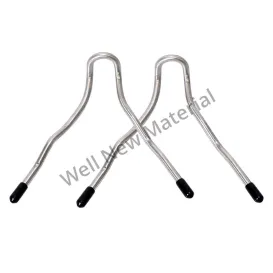Your Position: Home - Anchors - FAQs | Everything You Need to Know About Refractory Anchors
Refractory anchors are indispensable in the construction and upkeep of furnaces, kilns, and reactors that operate at high temperatures. These elements serve to secure the refractory linings, which safeguard the structural integrity from extreme heat and corrosive substances. This article aims to furnish readers with an extensive understanding of refractory anchors, detailing their types, uses, and advantages, so that both industry specialists and enthusiasts can appreciate their significance.
Understanding Refractory Anchors
Refractory anchors can be defined as metal or ceramic components employed to affix refractory linings to the inner surfaces of high-temperature equipment. Their primary role is to uphold the structural integrity of these linings, ensuring that they remain intact and do not peel off or collapse even under severe conditions. These anchors are available in a variety of shapes and sizes, customized for specific applications and lining materials.

Categories of Refractory Anchors
Different varieties of refractory anchors exist, each engineered to satisfy particular demands:
Y-Anchors: These anchors, resembling the letter Y, deliver exceptional support and are prevalent in dense refractory linings.
V-Anchors: V-shaped in design, these anchors are ideal for lightweight refractory linings.
U-Anchors: U-shaped anchors offer versatility and can be utilized in numerous refractory lining applications.
Ceramic Anchors: Composed of high-temperature-resistant ceramics, these anchors are critical in environments where metallic alternatives may oxidize or corrode.
Material Composition of Refractory Anchors
When selecting materials for refractory anchors, the operational environment and type of refractory lining should be taken into account. Common materials include:
Stainless Steel: Known for its superior corrosion resistance, it is applicable in a wide range of settings.
Inconel: This nickel-chromium alloy boasts high-temperature strength as well as oxidation resistance.
Ceramics: Utilized in extremely high-temperature settings where metals may fail.
Usage Scenarios for Refractory Anchors
Refractory anchors find application in various industrial settings operating at high temperatures, including:
Petrochemical Facilities: Anchors secure linings in reactors, reformers, or furnaces subject to corrosive gases and intense heat.
Cement Production: Vital for maintaining the integrity of linings in rotary kilns and other high-temperature apparatus.
Energy Generation: Utilized in boilers and incinerators, thereby resisting high heat and chemical degradation.
Metal Production: Crucial for enhancing the durability of linings in blast furnaces and other high-temperature equipment used in steelmaking.
Benefits of Refractory Anchors in Performance
Refractory anchors significantly contribute to the enhancement of refractory linings in terms of performance and durability:
Preventing Lining Failures: By securing the lining, anchors obstruct detachment and potential collapse due to thermal and mechanical stressors.
Accommodating Thermal Expansion: Anchors facilitate the handling of thermal expansion, thereby minimizing risks like cracking and spalling.
Optimizing Heat Distribution: Well-anchored linings contribute to even heat distribution, improving the efficiency of high-temperature operations.
Factors to Consider When Selecting Refractory Anchors
To ensure the optimal efficiency of refractory anchors, various considerations must be addressed:
Temperature Ratings: Opt for anchors composed of materials capable of withstanding the maximum operational temperatures encountered.
Environmental Chemistry: Evaluate the chemical make-up of gases and materials interacting with the lining to minimize the risk of corrosion.
Compatibility with Lining Material: Ensure the anchor’s type and composition align with the refractory lining being installed for maximum efficacy.
Installation Methods: Confirm that chosen anchoring systems can be installed securely, adhering to application-specific requirements.
Implementation and Care of Refractory Anchors
The installation and ongoing care of refractory anchors are essential for their functionality:
Installation Process: Proper spacing and depth are vital for supportive installation of anchors, utilizing reliable methods such as welding or threading.
Routine Inspections: Performing regular evaluations for signs of deterioration, corrosion, or damage to both anchors and linings is recommended.
Timely Replacement: It is crucial to replace anchors that exhibit wear or corrosion to sustain the integrity of the refractory lining and mitigate unnecessary downtimes.
Advantages of Utilizing Refractory Anchors
Refractory anchors provide numerous advantages in high-temperature settings:
Increased Lifespan: They effectively enhance the longevity of refractory linings by preventing unauthorized detachment.
Safety Improvements: Secure linings lower the likelihood of catastrophic failures, ensuring safer operation.
Cost Efficiency: By prolonging the lifespan of linings while reducing the frequency of maintenance, refractor anchors serve as a cost-effective solution for industrial applications.
Final Thoughts
In summary, refractory anchors are vital for the construction and maintenance of high-temperature industrial equipment. Understanding their types, material properties, applications, and installation practices is critical for maximizing their benefits and ensuring reliable performance in challenging industrial environments.
185
0
0
Previous: None
Next: none
Comments
All Comments (0)